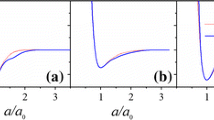Abstract
An n-body Ni-Nb-Ta potential is constructed to conduct molecular dynamics simulations using 129 solid solution models with various compositions. Comparing the relative stability of solid solutions versus their disordered counterparts, simulations determine two critical solid-solubility lines, which define a region in the composition triangle. If an alloy is located inside the defined region, a disordered state is energetically favored; if it is located outside, a crystalline solid solution is preserved. The region is therefore named as the metallic glass-forming region.
Similar content being viewed by others
References
M.H. Lee, J.H. Kim, J.S. Park, J.C. Kim, W.T. Kim, and D.H. Kim: Fabrication of Ni–Nb–Ta metallic glass reinforced Al-based alloy matrix composites by infiltration casting process. Scr. Mater. 50, 1367 (2004).
M. Lee, D. Bae, W. Kim, and D. Kim: Ni-based refractory bulk amorphous alloys with high thermal stability. Mater. Trans. 44, 2084 (2003).
K.D. Kim, K.B. Kim, Y.C. Kim, D.Y. Lee, and D.H. Kim: Hydrogen permeation and surface characteristics of Pd-coated Ni–Nb–Ta amorphous alloy membrane. Mater. Sci. Forum 510–511, 810 (2006).
J.H. Li, X.D. Dai, S.H. Liang, K.P. Tai, Y. Kong, and B.X. Liu: Interatomic potentials of the binary transition metal systems and some applications in materials physics. Phys. Rep. 455, 1 (2008).
X.D. Dai, J.H. Li, H.B. Guo, and B.X. Liu: Structural stability and characteristics of the metastable Ag–W phases studied by ab initio and molecular dynamics calculations. J. Appl. Phys. 101, 063512 (2007).
S.H. Liang, J.H. Li, and B.X. Liu: Solid-state amorphization of an immiscible Nb–Zr system simulated by molecular dynamics. Comput. Mater. Sci. 42, 550 (2008).
X.D. Dai, Y. Kong, and J.H. Li: Long-range empirical potential model: Application to fcc transition metals and alloys. Phys. Rev. B 75, 104101 (2007).
X.D. Dai, J.H. Li, and Y. Kong: Long-range empirical potential for the bcc structured transition metals. Phys. Rev. B 75, 052102 (2007).
G. Kresse and J. Hafner: Ab initio molecular dynamics for liquid metals. Phys. Rev. B 47, 558 (1993).
G. Kresse and J. Furthmuller: Efficient iterative schemes for ab initio total-energy calculations using a plane-wave basis set. Phys. Rev. B 54, 11169 (1996).
P. Villars and L.D. Calvert: Pearson’s Handbook of Crystallo-graphic Data for Intermetallic Phases (ASM International, Materials Park, OH, 1997).
M. Parrinello and A. Rahman: Polymorphic transitions in single crystals: A new molecular dynamics method., J. Appl. Phys. 52, 7182 (1981).
M.P. Allen and D.J. Tildesley: Computer Simulation of Liquids (Oxford University Press, London, 1987).
D. Frenkel and B. Smit: Understanding Molecular Simulations: From Algorithms to Application (Academic Press, San Diego, 2002).
L.J. Gallego, J.A. Somaza, J.A. Alonso, and J.M. Lopez: Prediction of the glass formation range of transition metal alloys. J. Phys. F: Met. Phys. 18, 2149 (1988).
K.P. Tai, L.T. Wang, and B.X. Liu: Distinct atomic structures of the Ni–Nb metallic glasses formed by ion beam mixing. J. Appl. Phys. 102, 124902 (2007).
W.S. Lai, Q. Zhang, and B.X. Liu: Solubility criterion for sequential disordering in metal-metal multilayers upon solid-state reaction. Philos. Mag. Lett. 81, 45 (2001).
B.X. Liu and Z.J. Zhang: Formation of nonequilibrium solid phases by ion irradiation in the Ni-Ta system and their thermodynamic and growth-kinetics interpretations. Phys. Rev. B 49, 12519 (1994).
F.R. de Boer, R. Boom, W.C.M. Mattens, A.R. Miedema, and A.K. Niessen: Cohesion in Metals: Transition Metal Alloys (Amsterdam, North-Holland, 1988).
T. Egami: Atomistic mechanism of bulk metallic glass formation. J. Non-Cryst. Solids 317, 30 (2003).
B.X. Liu, W.L. Johnson, M-A. Nicolet, and S.S. Lau: Structural difference rule for amorphous alloy formation by ion mixing. Appl. Phys. Lett. 42, 45 (1983).
Author information
Authors and Affiliations
Corresponding author
Rights and permissions
About this article
Cite this article
Dai, Y., Li, J.H., Che, X.L. et al. Glass-forming region of the Ni-Nb-Ta ternary metal system determined directly from n-body potential through molecular dynamics simulations. Journal of Materials Research 24, 1815–1819 (2009). https://doi.org/10.1557/jmr.2009.0198
Received:
Accepted:
Published:
Issue Date:
DOI: https://doi.org/10.1557/jmr.2009.0198




